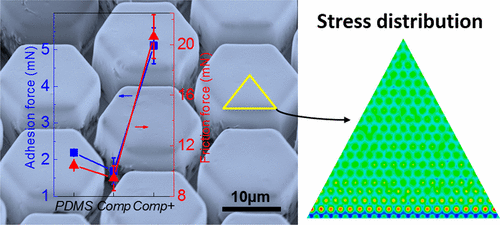Our official English website, www.x-mol.net, welcomes your
feedback! (Note: you will need to create a separate account there.)
Hybrid Surface Patterns Mimicking the Design of the Adhesive Toe Pad of Tree Frog.
ACS Nano ( IF 15.8 ) Pub Date : 2017-09-08 , DOI: 10.1021/acsnano.7b04994 Longjian Xue 1 , Belén Sanz 1, 2 , Aoyi Luo 3 , Kevin T Turner 3 , Xin Wang , Di Tan , Rui Zhang , Hang Du , Martin Steinhart 4 , Carmen Mijangos 2 , Markus Guttmann 5 , Michael Kappl 1 , Aránzazu Del Campo 1, 6, 7
ACS Nano ( IF 15.8 ) Pub Date : 2017-09-08 , DOI: 10.1021/acsnano.7b04994 Longjian Xue 1 , Belén Sanz 1, 2 , Aoyi Luo 3 , Kevin T Turner 3 , Xin Wang , Di Tan , Rui Zhang , Hang Du , Martin Steinhart 4 , Carmen Mijangos 2 , Markus Guttmann 5 , Michael Kappl 1 , Aránzazu Del Campo 1, 6, 7
Affiliation

|
Biological materials achieve directional reinforcement with oriented assemblies of anisotropic building blocks. One such example is the nanocomposite structure of keratinized epithelium on the toe pad of tree frogs, in which hexagonal arrays of (soft) epithelial cells are crossed by densely packed and oriented (hard) keratin nanofibrils. Here, a method is established to fabricate arrays of tree-frog-inspired composite micropatterns composed of polydimethylsiloxane (PDMS) micropillars embedded with polystyrene (PS) nanopillars. Adhesive and frictional studies of these synthetic materials reveal a benefit of the hierarchical and anisotropic design for both adhesion and friction, in particular, at high matrix-fiber interfacial strengths. The presence of PS nanopillars alters the stress distribution at the contact interface of micropillars and therefore enhances the adhesion and friction of the composite micropattern. The results suggest a design principle for bioinspired structural adhesives, especially for wet environments.
中文翻译:

模仿蛙类脚趾垫设计的混合表面图案。
生物材料通过各向异性构造块的定向组件实现定向加固。一个这样的例子是树蛙脚趾垫上的角化上皮的纳米复合结构,其中(软)上皮细胞的六边形阵列被密集堆积和定向的(硬)角蛋白纳米原纤维交叉。在这里,建立了一种方法来制造由树蛙启发的复合微图案阵列,该复合微图案由嵌入了聚苯乙烯(PS)纳米柱的聚二甲基硅氧烷(PDMS)微柱组成。这些合成材料的粘合和摩擦研究显示出分层和各向异性设计对于粘合和摩擦的好处,特别是在高基质纤维界面强度的情况下。PS纳米柱的存在改变了微柱接触界面处的应力分布,因此增强了复合微图案的附着力和摩擦力。结果表明了生物启发性结构胶粘剂的设计原理,尤其是在潮湿环境中。
更新日期:2017-09-08
中文翻译:

模仿蛙类脚趾垫设计的混合表面图案。
生物材料通过各向异性构造块的定向组件实现定向加固。一个这样的例子是树蛙脚趾垫上的角化上皮的纳米复合结构,其中(软)上皮细胞的六边形阵列被密集堆积和定向的(硬)角蛋白纳米原纤维交叉。在这里,建立了一种方法来制造由树蛙启发的复合微图案阵列,该复合微图案由嵌入了聚苯乙烯(PS)纳米柱的聚二甲基硅氧烷(PDMS)微柱组成。这些合成材料的粘合和摩擦研究显示出分层和各向异性设计对于粘合和摩擦的好处,特别是在高基质纤维界面强度的情况下。PS纳米柱的存在改变了微柱接触界面处的应力分布,因此增强了复合微图案的附着力和摩擦力。结果表明了生物启发性结构胶粘剂的设计原理,尤其是在潮湿环境中。











































 京公网安备 11010802027423号
京公网安备 11010802027423号